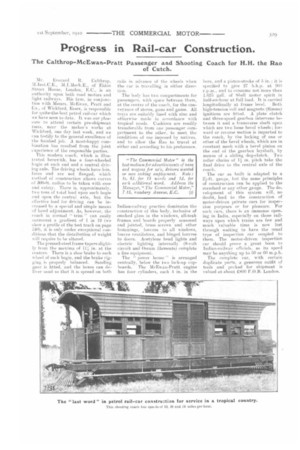Progress in Rail-car Construction.
Page 7

If you've noticed an error in this article please click here to report it so we can fix it.
The Calthrop-McEwan-Pratt Passenger and Shooting Coach for H.H. the Rao
of Cutch.
Mr. Everard B. Calthrup,
M.I.Merh.E., of Eldon .Street House, London, E.G., is an authority upon both road motors and light railways. His firm, in conjunction with Messrs. MeEwan, Pratt and of Wickford. Essex, is responsible hr quite-the-best petrol rail-car which we have seen to date. It was our pleasure to attend certain pre-shipment tests, near the maker's works at Wickford, one clay last week, and we can testify to the general excellence of the finished job. A most-happy combination has resulted from the joint experience of the responsible parties. This modern coach, which is illustrated herewith, has a four-wheeled bogie at each end and a central driving axle. The driving wheels have 5-in. faces and are not flanged, which method of construction allows curves It 300-ft. radius to be taken with ease and safety. There is, approximately-, tau tons of total load upon each bogie and upon the central axle, but the effective load for driving can be increased by a speeial and simple means of hand adjustment. As, however, the coach in normal " trim " can easily surmount a gradient of 1 in 19 (we show a profile of the test track on page 540), it is only under exceptional conditions that the distribution of weight Will require to be altered.
The pressed-steel f Tame tapers slightly from the maxima of 14 in. at the centres. There is a shoe brake to each wheel of cad' bogie, and the brake rigging is properly balanced. Sanding gear is fitted, and the boxes can deliver sand so that it is spread on both roils in titvauce of the wheels when the ear is travelling in either direction.
The body has two compartments for passengers, with space between them, at the centre of the coach, for the conveyance of stores, guns and game. All trays are suitably lined with sine and otherwise made in aceordance with tropical needs. Cushions are readily transferable from one pas.senger compartment to the other, to meet the conditions of use imposed by natives, And to allow the IN° to travel at either end according to his preference.
Indian-railway practice dominates the construction of this body; inclusive of smoked 0:hiss in the windows, all-teak frames nod boards properly seasoned and jointed, brass screws and other fastenings, louvres to all windows, louvre ventilators, and hinged louvres to doors. Acetylene head lights and electric lighting internally 48-volt circuit and Osram filaments) complete a fine equipment.
The " power _house " is arranged centrally, below the two lock-up cupboards. The MeEivan-Pratt engine has hour cylinders, each 4 in. in the bore, and a piston-stroke of 5 in.; it is specified to give 27 b.h.p. at 000 r.p.m., and to ansume not more thou 1.025 gall. of Shell motor spirit in half-an-hour at full load. It is earried
longitudinally at frame level, Both high-tension coil and magneto (Simms) ignitions are fitted. A plate clutch and three-speed gearbox intervene between it and a transverse shaft upon which are two loose bevel wheels; forward or reverse motion is imparted to the coach, by the locking of one or other of the bevel wheels, which are in constant mesh with a bevel pinion on the end of the gearbox layshaft, by means of a sliding dog-clutch. Two roller chains of 141 in. pitch take the final drive to the central axle of the coach.
The car as built is adapted to a 2L--ft. gauge, lnit the same principles of construction can be applied to the standard or any other gauge. The development of this system will, no doubt, lead to the construction of motor-driven private cars for inspection purposes or for pleasure. For such cars, there is an immense opening in India, especially on those railways upon which trains are few and mulch valuable time is now lost through waiting to have the usual type of inspection car coupled to them. The motor-driven inspection car should prove a great boon to Indian-railway officials, as its speed may be anything up to 50 or 60 m.p.h.
The complete car, with certain duplicate parts, a generous outfit of tools and packed for shipment is valued at about 1:800 F.O.B. London.






















